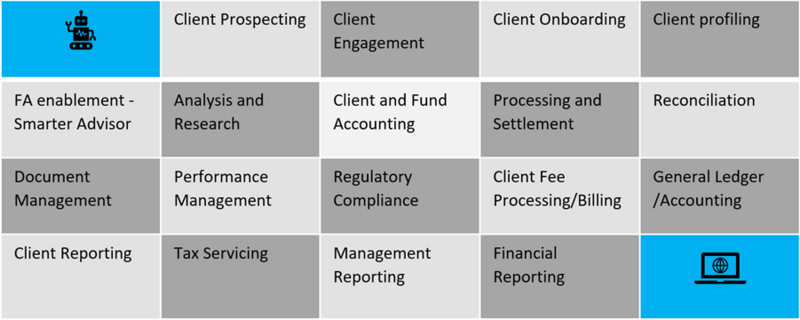While the quantum of revenue is not a concern anymore, Wealth Management firms are still struggling with a high Cost to income ratio due to which the industry has seen margin compression for the past many years.
The industry has also witnessed increased competition from low-cost service providers and Robo advisors especially catering to the mass affluent market. Industry players are actively trying to increase productivity and reduce costs by identifying processes that can be automated, one of the levers that they are looking for is “Cognitive Automation”.
Cognitive Automation
Cognitive Automation enables faster processing with the understanding of natural language, self-learning, and the ability to handle scenarios with unstructured data.
Non-standard documents are handled in a coherent manner and decision-making is enabled based on complex rules and composite interactions with multiple systems. Automation is a fast-emerging enabler with different organizations placed at different stages of maturity.
Robotic Process Automation (RPA) is widely used across the industry whilst more mature players are slowly but steadily heading towards Cognitive Automation. Large-scale automation across enterprises helps to overcome process inefficiency, lowers error rates, improves productivity and performance, handles lack of process/ workflow standardization, and increases speed and accuracy with the ability to handle higher volumes.
Firms must take a holistic enterprise-wide approach to automation. Automation must be a business requirement and end-user experience-driven, based on the existing capabilities and solutions. Firms need to drive enterprise-wide automation through a CoE approach with representation from Business, IT, and operations across LOB for maximum benefits realization and to ensure key stakeholder buy-in and seamless deployment. We have seen many firms failing to realize the value of automation due to siloed approach. The CoE approach also helps in appropriate process identification.
The importance of efficiency
When we think about redefining wealth management processes, then process excellence appears to be a key differentiator. Process excellence is not all about specific techniques, it’s more about redefining the way enterprises generate and unlock value for their customers.
Firms need to understand that productivity depends on efficient processes which means eliminating sterile processes, that is only possible when the process mining technique is administered to evaluate the efficiency of all existing processes including client onboarding, customer acquisition, and risk profiling, along with designing customized products and ensuring compliance to regulatory requirements.
The role of data
Embracing process excellence is a journey that is addressed through multiple distinctive phases, each phase has a specific role to play. Process mining is inconceivable without data analysis. Data plays a critical role in shaping the entire journey. The entire journey can be classified broadly into four sub-phases:
Discovery: Data-driven process analysis identifies process incompatibilities using exemplary process mining tools, which are the foundation of the discovery phase. During this analysis for wealth customers identification of needs and reporting capabilities are analyzed appropriately.
Reimagining: Process innovation techniques leverage cognitive process expertise on top of industry knowledge to design efficient future-ready processes. Wealth firms more frequently depend on big data analytics implemented on cloud platforms to harness data-intensive process reimagining.
Automation: Processes suitable for automation are identified with the help of design thinking techniques. Process requirements are defined at a very granular level. Primarily looking at what the process owners aspire to and whether it is technically feasible to automate the process. As mentioned, the process is already validated earlier as an efficient process.
Return Analysis: Overseeing all those transformed processes post-automation through well-defined continuous improvement plans, and intermittent measurement of business KPIs to see whether the result of the automation transformation program is meeting the stakeholder’s expectations.
Through the above framework, it has been observed that there is wide applicability of automation in Wealth Management and there are plenty of use cases from Front to Back for using automation. Below table lists areas where Automation can be adopted.

Wealth management firms
Majority of the wealth management firms take advantage of the host of legacy applications those are existing across several internal platforms, with a gradual transition from one system to another, without focusing on the identification of the right process and reimaging of the same, hence most of the time such transformation programs fail to deliver results.

It must be understood that automation is an enabler and not a disrupter for an advisor-driven wealth model. Financial advisors will remain core to wealth management for foreseeable future. Cognitive Automation deployment will help improve the productivity and efficiency of advisors.
Embracing Intelligent workflow will help Wealth Management Industry to Achieve Cost Reduction, become Compliant with regulatory requirements, innovate at a fast-moving speed, and improve customer experience.
Conclusion
Key strategies the wealth firms can adopt to embrace post-pandemic changes and scale further:
- Identifying the firm’s inherent competitive strategy and designing an offering that brings its unique selling propositions.
- Revalidation and screening of existing processes, adoption of Lean approach
- Embracing innovations and collaborating with the fintech in growing the customer footprints
- To focus more on hyper-personalization by leveraging AI and ML to augment data and analytics capabilities
- Redesigning the digital target operating model keeping in mind organization, people, process, and technology
In our future studies, we will focus more on each specific area and elaborate on how the strategies can be implemented to tangible outcomes.












